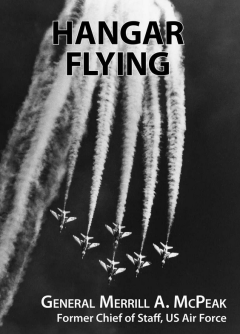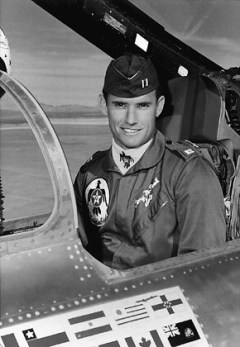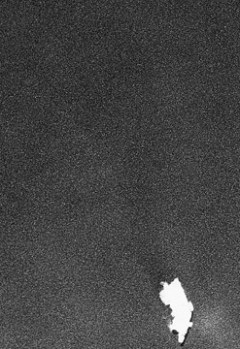 Merrill “Tony” McPeak served as the U.S. Air Force’s 14th chief of staff – its top officer – from 1990 to 1994. A fighter pilot — who flew over Vietnam, in war, and as a member of the Air Force’s Thunderbirds aerial acrobatic team, in peace – McPeak ran the service during 1991’s Gulf War. He has always been an outspoken advocate of air power’s role in combat.
Merrill “Tony” McPeak served as the U.S. Air Force’s 14th chief of staff – its top officer – from 1990 to 1994. A fighter pilot — who flew over Vietnam, in war, and as a member of the Air Force’s Thunderbirds aerial acrobatic team, in peace – McPeak ran the service during 1991’s Gulf War. He has always been an outspoken advocate of air power’s role in combat.
The retired four-star general has just published his autobiography. Well, actually it’s just the first of three planned volumes. No one who knows the semi-loquacious McPeak will be surprised by that (for proof, simply check out http://generalmcpeak.com/). Battleland recently conducted an email chat with McPeak about the first of the trio, Hangar Flying, which focuses on the 1960s, his early days in the sky, and Vietnam:
Why did you want to be a pilot?
When I went to college the Air Force paid students a small stipend to enroll in ROTC. I needed the cash and that’s how I ended up getting a reserve commission. I scored well in tests for flying aptitude and as a child I’d formed a romantic image of pilots from World War II films. But I didn’t really fall in love with flying until I reported for pilot training and started actually doing it. I got hooked, quite frankly. Where else can you do something that’s so much fun and get paid for it?

Hangar Flying
What did the Vietnam War teach a young Tony McPeak?
The worst mistake anyone in a leadership position can make is to fool himself about the facts of a situation. Never let a predisposition or expectation affect your judgment about external circumstances. Observe closely. Allow the actual photons that strike the eyeball to flow up the optic nerve to the cortex. Act on fact, not prejudice or dogma.
The tendency to base decisions on myth rather than fact is a special danger for politicians, who must make a career of fooling others. Lyndon Johnson seemed incapable of an objective analysis of what was happening in Southeast Asia. He believed what he said, what he wanted to believe, ignoring the altogether too obvious evidence at hand.
But military leaders, whose sterner training is meant to provide a firm grounding in reality, can fall into this trap also, as Westmoreland did. And when a senior military leader becomes delusional, lives are at risk immediately and on a large scale. The result is a sort of Greek tragedy, which is how I see the Vietnam War.
How did you apply those lessons later in your career?
Never—repeat never—kid yourself about your situation. This does not mean never take risk. In fact, rather often doing nothing is the riskier choice. But weigh the odds in the context of a realistic view of the circumstances and try to pick the wisest course of action.
By the way, the quality of being good at doing this is called “judgment.”

Hangar Flying
Tell us about the first-ever Thunderbird crash before an audience…when you were at the controls.
My accident at Del Rio, Texas was the first in which we destroyed an aircraft in front of a crowd during an official air show.
The wings on my F-100 failed during the pull up to do vertical rolls through the Diamond Bomb Burst. I didn’t know the wings had folded; from inside the cockpit, it just seemed as though the aircraft exploded.
I jumped out at high speed, no big deal. Nobody in the audience was hurt, all the pieces landed on government property, and we were able to fix a structural problem in the F-100 fleet worldwide, which probably saved some lives. If you have to have an accident, it was the good kind to have.
Talk about your Cold War nuclear mission.
In those years as a primary duty aircrew member, I was highly skeptical about our ability to pull off the mission that was required of us.
When I first began pulling nuclear alert with an F-100—Victor Alert, as we called it—one of my targets was Peenemunde, an East German fighter base. In World War II, it had been the scene of the German rocket establishment experimental base; this was where the V-1 and V-2 rockets were developed, in Peenemunde, up on the Baltic Sea. They could shoot them out over the water, and when they crashed, which they predictably did most of the time, nobody got hurt. By the Sixties, the base had been converted into an East German Air Force fighter base. They had fifty fighter aircraft there. My job was to blow it up with a nuclear weapon.
Our targets changed every six months or so, so I didn’t always stay on Peenemunde. And it wasn’t always me who was responsible for Peenemunde. I would pull alert with that as my target, and I’d be relieved by another pilot who would come in and have it as his target. Also, Peenemunde was a fairly important target; therefore it’s likely that people in other squadrons away from my base were assigned to attack it also. Peenemunde probably had three or four aircraft assigned to attack it, which is good because not all three or four were going to get through, believe me. That was part of my skepticism.
We had to attack this target from a base in the U.K., where the daylight hours are limited in the wintertime and the weather was nearly always bad. Just finding Peenemunde would have been difficult even in bright daylight in July, even more so in restricted visibility, low cloud, or at night.
Presuming we found it, we had to perform a delivery maneuver, which was, at the beginning, a modified loop. You pulled the airplane into a climb, released the weapon going up in a maneuver we called “over the shoulder”—you felt like you were tossing this thing over your shoulder—and then rolled away, trying to get back toward friendly territory.
You had to do this so the weapon would fly up and give you some separation time from the bomb, which turned around and started dropping until, at a certain altitude, a radar-altimeter type of fuse would explode it for an airburst. And of course you had to get away from this massive explosion, typically something like three or four times as powerful as the munitions we used on Hiroshima and Nagasaki. So it was important you had a little time to get away.
Well, I always thought it was kind of dumb to believe you could take off in bad weather, in the middle of the night, find this place, and then do an aerobatic maneuver in order to get safe separation from the blast and shock and flash effects and so forth.
Actually, when we were on alert, we had a little eye patch, a sort of Moshe Dayan-black eye patch, which we were supposed to put on before launch. Over this part of Europe, if anything were to happen, a lot of nuclear weapons would be going off, and of course the flash would blind you. At least with this eye patch you’d still had one eye left to find your target. That was the thinking.
It was that kind of thing that made me skeptical about whether we would be able to pull off this sort of attack. In contrast to say, intercontinental ballistic missiles, which had a very good chance of getting through, or the bombers: Strategic Air Command, six guys in a B-52, and an entirely different style of attack—you’re going to drop this bomb from high altitude and so forth. That was a different scenario for delivering nuclear weapons, and pretty believable, that they could do it.
I was always kind of skeptical the fighter force would be able to pull this off. But the other side couldn’t count on us not being able to do it.
This 350-page book takes readers only through Vietnam. Volume 2 is slated to cover your career in the 1970s and 1980s, while the third volume will cover your time as the Air Force chief of staff from 1990 to 1994. Why is Tony McPeak worth three volumes and 1,000 pages?
I think the three volumes may come in under 1,000 pages, but that’s a quibble. It’s a fair, if pointed question. I’ll answer in two ways.
First, of course this is my story. But, at bottom, none of the books is about me. Hangar Flying is about flying. If you want to read up on this subject, there are some high quality books out there. One thinks of Wind, Sand, and Stars (Antoine de Saint-Exupéry), Fate is the Hunter (Ernest Gann), Going Solo (Roald Dahl), The Hunters (James Salter), or Inside the Sky (William Langewiesche). But books about flying also seem in high demand, the market apparently not saturated.
And none of the titles mentioned above has much to say about squadron service during the Cold War, or air show flying, or air combat in Vietnam.
The second book, Below the Zone, is slated for publication in 2014. It’s about leadership and management, joining the Niagara of “how to” books on this topic currently warping library shelves.
And 2016 should see the appearance of the last book, Roles and Missions. It concerns itself with national security issues of the early 1990s: Desert Storm, Bosnia, Mogadishu, gays in the military, women in combat, the decline in defense budgets brought on by the so-called Cold War dividend.
My contribution on any of these topics may or may not be worth reading, but there does seem to be lively interest in all of them.
Second, very few service chiefs have published memoirs. (Powell was a chairman of the joint chiefs; Schwarzkopf, Franks and Clark were commanders in operational theaters.) Elmo Zumwalt’s On Watch (published 1975) is the most recent noteworthy memoir by a service chief, Hap Arnold’s Global Mission (published 1949), the last interesting work by an Air Force chief of staff.
This is an unexpected outcome, in a way, since the individual services are the keepers of military culture and worldview. If there is any demand for a book about the early training needed to produce the uniformed head of a one of our armed services, there is almost nothing in the way of supply.
When collected, the three books will be called The Aerial View, and will contribute, I think, to an understanding of modern airpower. Neither the theory nor the application of airpower is well understood, which is to be expected with a form of combat only 100 years old. The Aerial View might be airpower’s version of Clausewitz’s Vom Kriege, or Mayan’s The Influence of Sea Power upon History, except easier to read.
Still, you ask a good question.


